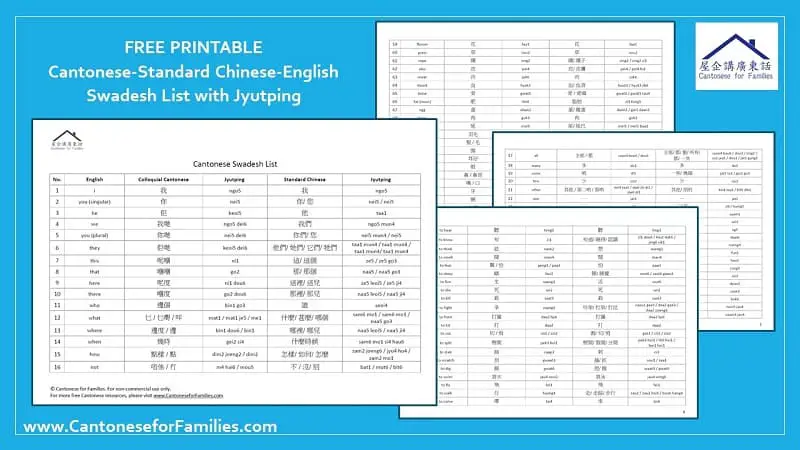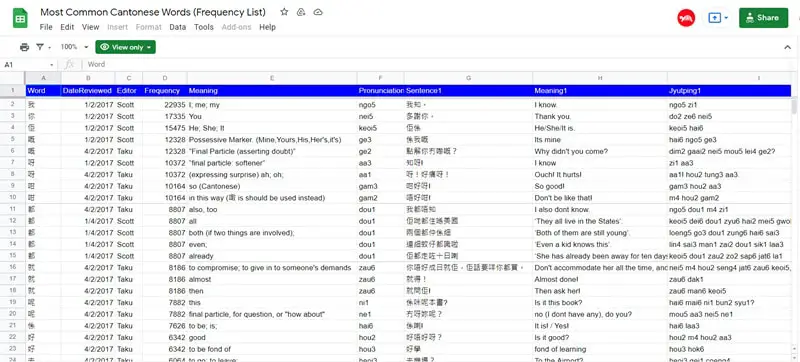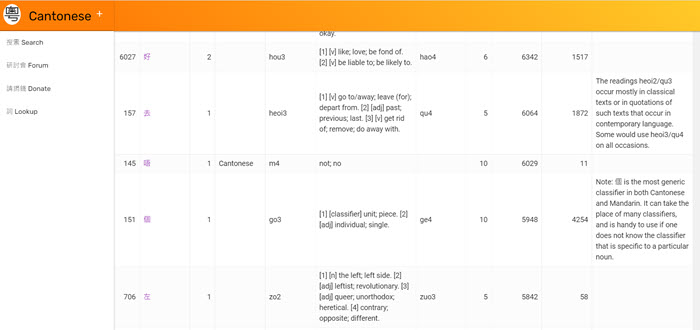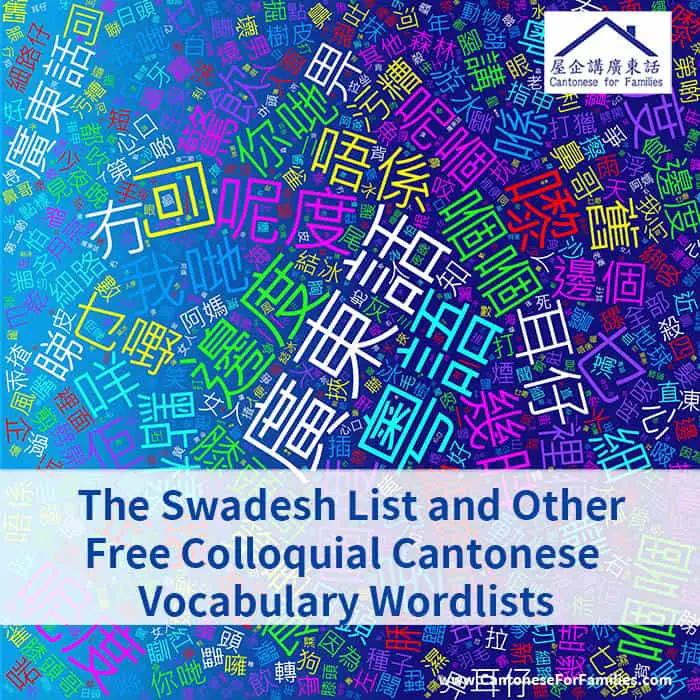One thing I have found useful in learning/teaching languages is the use of vocabulary lists or word lists. In fact, if you look through some of my past posts, you’ll find that I have often compiled vocabulary lists for different topics, found throughout the Cantonese for Families blog.
How to use Wordlists
Wordlists are, of course, not to be used in isolation in language learning/ teaching. The key to any tool is to be aware of its limitations, as well as one’s style of learning. With wordlists, it is worth bearing in mind that words are meant to be used in context. It would be quite meaningless to just memorize the list. For this reason, some people are against word lists and flashcards. Indeed, some people learn well with pure immersion, but others like me require scaffolding and structure, which wordlists provide.
How I use them:
- To familiarize myself with more vocabulary, especially related to a topic. This provides me the scaffolding needed when I am listening to or reading.
- For checking gaps in vocabulary that I know
- Vocalisation – to check if I or my kid can pronounce the words or phrases. My kid has difficulty with pronunciation, so I might get her to say out loud certain words or sentences (especially high frequency words) so that I might correct her pronunciation, which boost her confidence in speaking.
- Use it as a starting point to decide what to to teach / learn – For example, I pick key words that I would like my kid to learn, and then consciously use them when speaking to her, to provide her more meaningful input (I definitely do not expect her to memorise wordlist)
Some people also use wordlist to create flashcards, either physical or digital, and memorize them using the space repetition technique; creating stories.
There are many types of wordlists for learning a language, though unfortunately, not that many are available for Colloquial Cantonese.
Colloquial Cantonese Free Wordlists
Here are some of the free ones I have found online, each with their limitations. Of course one can create new lists, but for those unmotivated or short of time as myself, I prefer to use
1) Swadesh List
A Swadesh list is a compilation of basic words or concepts in each language, to enable linguists to compare languages. There are over 200 languages with Swadesh lists, so you can compare Cantonese with many other language, which is especially if English is not your native tongue.
How a Swadesh list is helpful in language learning
- understand the relationship between different languages e.g. It is interesting to see a comparison of languages, and how one word in Cantonese can mean a few different words in English. A classic example is 佢 can mean he/ she/ it in English.
- for language learners to get an introduction into basic core vocabulary when learning a new language, and is a good reference, though by no means a standalone.
One must also note the drawbacks of the Swadesh List:
- a Swadesh list does not demonstrate what is unique about a language, e.g for Cantonese – the final particles
- you can’t understand grammar and syntax from it, because it consists mainly of words and phrases
- it includes more basic terms that have stood the test of time, but will not include newer phrases e.g. internet, radio.
- it is not to be confused with a frequency list of that language. It is based on what is commonly found in many languages.
English -Cantonese-Standard Chinese Swadesh List (Free Printable)
As there are both a Cantonese list and a Mandarin list in existence, I compiled them both into a list that shows the comparison between English- Cantonese- Standard Chinese. I added in Jyutping as well. This is useful for me to see the comparison between Cantonese and Standard Chinese. You can also compile your own Swadesh list(s) integrating various other languages.
Free download

The FREE English- Cantonese- Standard Chinese Swadesh List Printable can be downloaded here.
2) Frequency Lists
In the learning of languages, I have found frequency lists to be most helpful. Based on the Pareto Principle of 80-20, learning high frequency or more common words upfront will be beneficial, as these words will help you understand the language more. For those of you with young kids, you might have seen this Frequency Principle used in the teaching of reading in English (Dolch/ Fry/ Magic words) and/or Chinese (Sagebooks)
Do note that vocabulary frequency lists are not created equal. There can be a variety of frequency list, depending on the source, E.g. spoken or written (the former can be created by analyzing subtitles, the latter analyzing books), target audience (adults vs children), and for some languages, whether they are based on characters or based on phrases. Often, a list does not come with background information on how it is derived, so please keep this in mind when using a frequency list. E.g. a child’s frequency list will have different words from an adult’s frequency list. Fairies and unicorns are unlikely to feature on the latter list.
Frequency lists are easily found for most languages, but I found it more difficult to find one for Colloquial Cantonese. But if improving your spoken Cantonese is important, you will need to have specific Colloquial Cantonese resources.
Here are some that I have found on the internet for free, that you can use as reference, but do note the limitations of each. I used them for reference, and to refresh my memory, but not for studying.
Most Common words in Spoken Cantonese (Frequency List)
Free download – I found the Most Commonly used Cantonese words (Frequency List) via a reddit post – This list initiated by someone named Scott, a Westerner learning Cantonese, and the list is being cleaned up with community input and feedback. The list still requires cleaning up (feel free to volunteer if you are a native speaker), so please do not take the list as gospel. It is also worth checking back to see if it has been updated. Also, do note that there might be some errors.

Scott has since set up a website and a Patreon.

Memrise
Memrise has a course with the most 375 most common Cantonese words/ phrases. 375 is a rather low number, so this will be more suited for beginners.
Cantonese 101
Cantonese101 has a list of core 100 words. Not sure how they came about the list because it has words such as 啤酒 (beer) and 程式設計員 (programmer). A subscription is needed to access beyond 100 words. (I was not able to check this out). They also have a list for 100 most common nouns, 100 most common verbs, 100 most common adjectives and 100 most common adverbs.
3) Thematic Vocabulary Lists
If you need to talk about a certain topic (e.g. Mid-Autumn Festival), it helps to have a vocabulary list on that topic to refer to.
I have listed some free vocabulary/ phrase lists on this blogpost ‘Online Colloquial Cantonese Phrase Lists’, and I have also created various vocabulary lists for many of the festivals and other themes.
I have even bought a few books with such lists that I can refer to frequently. And I bought some kids versions which are essentially Visual Dictionaries.
Lists of Slangs
Oxford dictionary defines slang as very informal words and expressions that are more common in spoken language, especially used by a particular group of people, for example, children, criminals, soldiers, etc. Linguists debate over whether colloquialism and jargon are synonymous with slang. The use of slangs, colloquial expressions in every language also change with time.
Free download – I found a website hosting a list of Cantonese slangs and colloquial terms online – Dictionary of Cantonese Slang, taken from the book of a similar name. It comes with Jyutping and English translations. You can download it as an Excel file or a PDF file (353 pages long).

I love learning about Cantonese slangs and colloquial expressions – they are what makes Cantonese unique. I have a few books on Cantonese Colloquial expressions too, and I am slowly building my library.
Do you use Wordlists?
Do you use wordlists in your studies/ teaching of Cantonese? How do you use them? If you know of any other wordlists, especially for Cantonese, please leave us a comment and share it. In an upcoming blogpost, I will share wordlists for learning Chinese characters.
For More Online Cantonese Resources:
- Free Online Resources for Learning Cantonese
- Online Cantonese Dictionaries
- Themed Colloquial Cantonese Phrase Lists
- Online Cantonese Tools
- Cantonese Dictionary and Translator Mobile Apps
- Free Online Cantonese Literature
You might also enjoy reading
- Colloquial Cantonese Kids’ Educational Resources and Printables
- Colloquial Cantonese Books for Kids Part 1 – Visual Dictionaries
- Your Ultimate Guide to Free Sagebooks Resources 基礎漢字500 on the Internet
- How to Create a Cantonese-Rich Environment
- Free Leveled Readers with Colloquial and Formal Cantonese Audio
- Free Online Chinese Textbooks and Course Materials


I’m still at the stage of learning where just about every Cantonese Youtube video I watch has words that are unfamiliar to me. I add those words to my own word list. The benefit is that I’ll add words that I think actually might be useful to me. The drawback is that I typically only write down the English definition, which helps me learn the meaning, but might not be enough to help me use it. For instance, I have both so2 gin3 所見 and gun1 caat3 觀察in my word list, both translate to “observe”, but I found out tonight they aren’t interchangeable. Once I find out more usage information, I then annotate my notes. This kind of ambiguity introduces uncertainty and hesitancy in using these words in the wild, for fear of using them incorrectly. For that reason, I’ve found that wordlists are slightly more helpful in helping me understand the language than in helping me speak it.
My list isn’t really worth sharing – they are words specific to what I want to learn, at the stage of learning I’m at (and for similar reason, other standard lists are of little use to me).